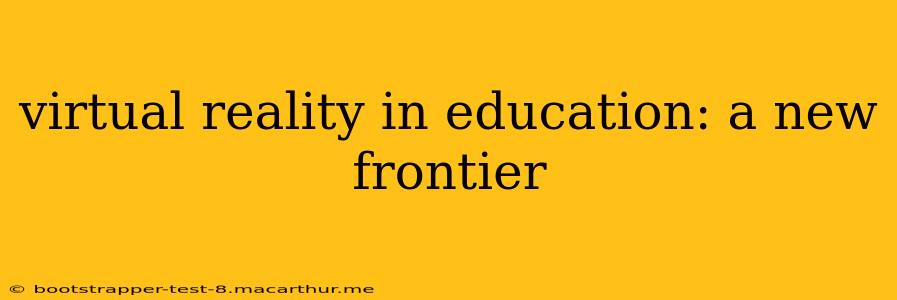Virtual Reality (VR) is rapidly transforming numerous sectors, and education is no exception. This immersive technology offers unprecedented opportunities to enhance learning experiences, making education more engaging, effective, and accessible. From simulating historical events to dissecting the human heart, VR's potential in the classroom is vast and exciting. This article explores the transformative impact of VR in education, addressing common questions and highlighting its future potential.
What are the benefits of using VR in education?
The benefits of incorporating VR into educational settings are multifold. Firstly, VR enhances engagement and motivation. Unlike traditional learning methods, VR provides an interactive and immersive experience that captures students' attention and sparks their curiosity. Students become active participants, not passive observers, leading to improved knowledge retention and deeper understanding. Secondly, VR offers unparalleled opportunities for experiential learning. Students can explore historical sites, conduct scientific experiments, or travel to distant lands—all without leaving the classroom. This hands-on approach fosters a deeper understanding of complex concepts and strengthens problem-solving skills. Finally, VR can personalize learning experiences, catering to diverse learning styles and needs. Adaptive VR programs can adjust the difficulty level and pace of learning to suit each student's individual requirements, ensuring everyone can thrive.
How can VR be used to improve student learning outcomes?
VR's ability to improve learning outcomes stems from its capacity to create realistic and engaging simulations. For example, history students can virtually visit ancient Rome, experiencing the city's sights and sounds firsthand. Science students can dissect a virtual frog without harming a living creature, gaining a detailed understanding of its anatomy. Students studying geography can explore diverse ecosystems, from the Amazon rainforest to the Arctic tundra. These experiences go beyond textbook learning, fostering deeper comprehension and a more holistic understanding of the subject matter. Furthermore, VR allows for risk-free experimentation. Students can make mistakes in a virtual environment without any real-world consequences, promoting a culture of experimentation and learning from errors.
What are some examples of VR applications in education?
Numerous educational institutions are already leveraging VR's potential. From elementary schools using VR to explore the solar system to universities utilizing VR for medical training, the applications are diverse and constantly expanding. Here are a few examples:
- History: Students can experience historical events firsthand, visiting ancient civilizations or witnessing pivotal moments in history.
- Science: Students can dissect virtual organisms, conduct experiments in a safe environment, or explore the human body in detail.
- Geography: Students can explore different geographical locations, understanding ecosystems and cultures firsthand.
- Language learning: Students can immerse themselves in virtual environments where they practice their language skills in realistic contexts.
- Special Education: VR can create tailored learning environments that cater to individual student needs, providing personalized support and encouragement.
What are the challenges of implementing VR in education?
While the potential benefits of VR in education are substantial, there are challenges to overcome. The cost of VR equipment can be a significant barrier for many schools and educational institutions. Furthermore, the technical expertise required to set up and maintain VR systems can be demanding. Curriculum integration also presents a challenge; existing curricula need to be adapted to effectively utilize VR technologies. Finally, ensuring equitable access to VR technology is crucial to avoid widening the existing digital divide.
What is the future of VR in education?
The future of VR in education is bright. As technology continues to evolve, VR headsets will become more affordable and user-friendly. Software development will lead to more sophisticated and engaging educational VR applications. We can anticipate the integration of Artificial Intelligence (AI) to personalize VR learning experiences even further, tailoring the content and pace to individual student needs in real-time. Ultimately, VR has the potential to revolutionize education, making it more engaging, effective, and accessible for all learners. The integration of VR into educational settings will not only improve learning outcomes but also transform the way we approach teaching and learning altogether.
